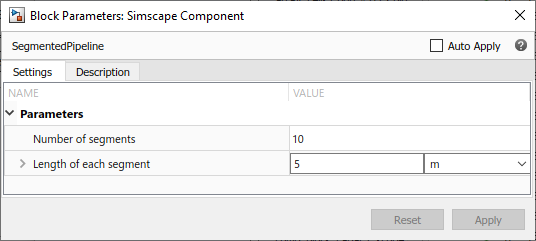Segmented Pipeline Using Component Array
This example shows how you can model a segmented pipeline using a component array. This
segmented pipeline model is a composite component that consists of
N identical segments connected in series. Individual pipe
segments are represented by the Pipe (IL) blocks from the
Foundation library. N is a parameter that the block user can modify.
component SegmentedPipeline
parameters
N = 10; % Number of segments
segm_length = { 5, 'm' }; % Length of each segment
end
% Ports at the two ends of the pipeline
nodes
A = foundation.isothermal_liquid.isothermal_liquid; % A:left
B = foundation.isothermal_liquid.isothermal_liquid; % B:right
end
% Declare array of N components
for i=1:N
components (ExternalAccess=none)
pipe(i) = foundation.isothermal_liquid.elements.pipe(length = segm_length);
end
end
% Connect all segments in series
for i=1:(N-1)
connections
connect(pipe(i).B, pipe(i+1).A);
end
end
% Connect two ends of pipeline to first and last segment, respectively
connections
connect(A, pipe(1).A);
connect(B, pipe(N).B);
end
endIn this example, for the sake of simplicity, the SegmentedPipeline
component has only two modifiable parameters: N (Number of
segments) and segm_length (Length of each
segment). However, you can make other parameters of the underlying
Pipe (IL) block accessible from the top-level composite
component block dialog, as described in Parameterizing Composite Components. Parameter N, which defines the
array size and is going to be used as the upper limit for the for-loop
iterator, is declared as a unitless integer.
Use a for-loop to declare an array of N member
components:
for i=1:N
components (ExternalAccess=none)
pipe(i) = foundation.isothermal_liquid.elements.pipe(length = segm_length);
end
end
In this example, all the pipe segments have the same length. For examples of array component members having different parameter values, see Segmented Pipeline with Different Pipe Lengths Using Component Array and Case Study — Battery Pack with Fault Using Arrays.
Use another for-loop to connect all segments in series, by connecting
node B of each pipe segment (except the last one) to node
A of the next segment:
for i=1:(N-1)
connections
connect(pipe(i).B, pipe(i+1).A);
end
end
Finally, connect the internal chain of segments to the two ends of pipeline, by connecting
node A of the composite component to node A of the first
segment and connecting node B of the composite component to node
B of the last segment:
connections
connect(A, pipe(1).A);
connect(B, pipe(N).B);
end
end
The resulting block has two isothermal liquid ports, A and B, and two modifiable parameters: Number of segments and Length of each segment.

